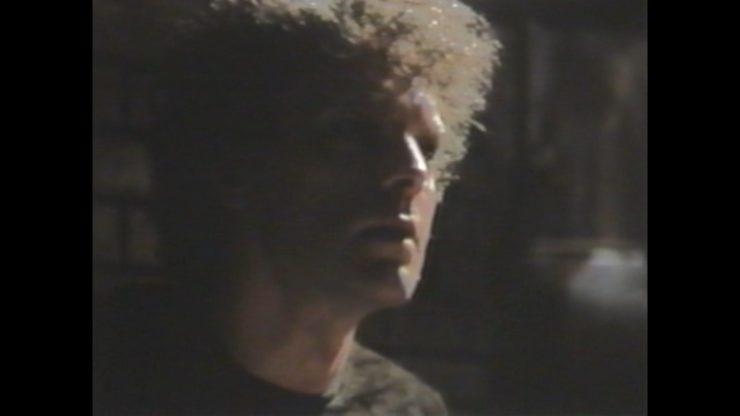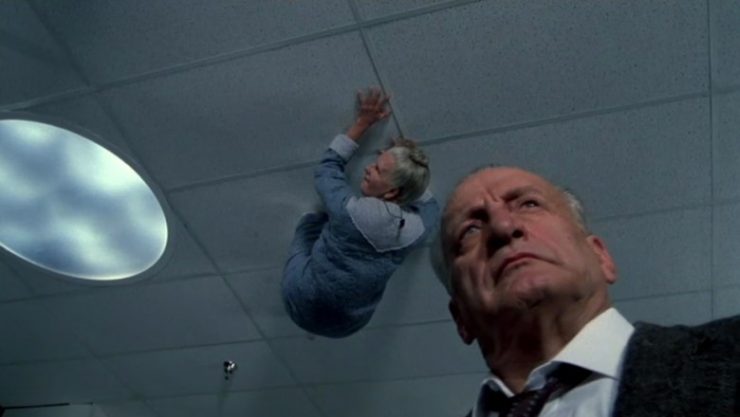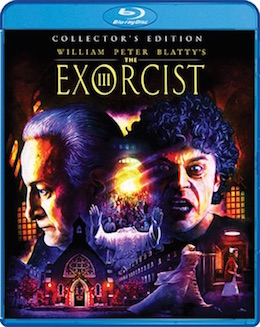Home video has brought about some great restorations of horror films previously available only in incomplete or mangled forms: the uncut version of The Wicker Man; the director’s cut of Guillermo del Toro’s first American film, Mimic; and even 1931’s Frankenstein, which had a supposedly blasphemous line of dialogue restored. But the one on my cinematic bucket list has always been William Peter Blatty’s original version of The Exorcist III.
The Exorcist series (which includes either four films or seven, depending on how you count) has been rich in competing cuts and suppressed versions. The original film’s theatrical cut is right up there with The Godfather and Citizen Kane as being pretty much perfect; Roger Ebert even used to teach a shot-by-shot breakdown of it. And yet, screenwriter and producer Blatty always felt that the original version didn’t quite capture his vision. So in 2000, he and director William Friedkin put together “The Version You’ve Never Seen,” including excised snippets that, in 1973, Friedkin felt rendered literal what had only been implied in the earlier release.
There’s only one version of Exorcist II: The Heretic, and that’s enough for anyone. But Blatty himself wrote and directed Exorcist III, based on his sequel novel Legion. The studio, Morgan Creek, turned down his original cut, which didn’t actually include an exorcism, and demanded reshoots with more flash, special effects, and general pandering to the horror audience. Blatty complied, but has always expressed the wish that his original version could be reconstructed. Now, thanks to Scream Factory, it has (although the restored version has to get by using VHS-quality inserts, since the missing footage could only be found in that form).

So, what’s the big deal about this “restoration”?
Blatty’s novel Legion is a dense thriller, with tangents that go off into mini-treatises on the nature of evil and God. There are two POV characters: Kinderman, the detective from The Exorcist, and Dr. Amfortas, a neurologist suffering from a brain lesion who’s also into EVP phenomena. Recent murders in and around a Georgetown hospital bear the mark of a supposedly deceased serial killer, the Gemini. The trail leads Kinderman to “Tommy Sunshine,” a former catatonic patient who looks just like Damien Karras, the heroic (and dead) priest of The Exorcist, yet claims to be possessed by the spirit of the Gemini. Amfortas’ plot thread runs counterpoint, showing how the effects of a physical brain injury can mimic those of possession, forcing the reader to debate the reality of possession, and by extension the reality of “Sunshine’s” insistence that he is, in fact, the Gemini.
Whew. Heavy stuff.
Blatty’s film version jettisons a lot of this (including the entire Amfortas plot) and turns it into a straight thriller. Doing so makes the movie both better and worse than the novel: better in that it’s a cleaner, less convoluted story, and worse because the ragged convolutions are the point of the novel. Amfortas talking to his lesion-generated double echoes Kinderman’s confrontations with the supposedly possessed Tommy Sunshine/Karras (there’s another red-herring subplot that implies a doctor may have hypnotically implanted the idea of the Gemini into Karras’s addled brain). All of this is cast aside in favor of a linear, cinema-friendly narrative. It’s interesting to recall that director William Friedkin threw out Blatty’s first attempt at a screenplay for the original Exorcist because it was too “movie-like”; here, without the influence of Friedkin’s perspective, Blatty makes the same choice.
And yet it’s hard to argue with what he wrought. First and foremost, he has a great cast. George C. Scott takes up the character originally played by Lee J. Cobb, and where Cobb used mumbling and bumbling to cover up Kinderman’s shrewd intelligence, Scott is a force of nature, bellowing and striding purposefully through scenes like he might actually, literally eat some of the scenery. His friend Father Dyer has been recast with Ed Flanders (the original Dyer was played by the Rev. William O’Malley, an actual Jesuit priest). Scott and Flanders have a terrific bantering relationship, and establish their friendship early and intensely.

In Blatty’s original cut of the film, Brad Dourif played both Father Karras and the Gemini, meaning that all the roles from the original film had been recast. Dourif’s certainly a powerhouse, snarling and charming his way through vile monologues a full year before Anthony Hopkins did the same in The Silence of the Lambs. And in the original cut, the climax of the movie centered on the Gemini’s attempt to kill Kinderman’s daughter.
But the studio, seeing that Blatty had composed a thoughtful, fairly bloodless horror movie, insisted that all this be changed. First, since it was now to be called The Exorcist III* instead of Legion, it needed to have…well, an exorcism. Further, since the Gemini was possessing the body of Father Karras, why not get the original Karras, Jason Miller, back for the role?
These changes did the story no favors. Nicol Williamson’s Father Morning, the new film’s exorcist, doesn’t interact with any of the other characters except Karras, and the whole exorcism scene is full of late-’80s special effects, none of which compare with the sheer power of Dourif’s performance in the original version. And speaking of Dourif, when it became obvious that the alcoholic Miller could never remember the lengthy Gemini monologues, Dourif was brought back in to redo them; for the most part, then, when it’s the Gemini speaking, we see Dourif, and when it’s Karras, we see Miller.
So the theatrical version of The Exorcist III feels like 3/4 of a great movie that falls apart at the end, giving its atmosphere and tension over to effects that, unlike those of The Exorcist, have no reality at all. Even Scott’s ferocious “I believe” monologue can’t salvage this.
But thanks to Scream Factory, we can see the film Blatty intended; or at least, as close as we’re likely to get. And it’s better; maybe not great, certainly not on par with The Exorcist, but not an embarrassment (like Exorcist II or Exorcist: the Beginning). It returns to the cosmic themes of the original film with weight and seriousness in both versions—but the director’s cut reveals Blatty’s very different vision, and whatever you may feel about that, it’s always the better choice.
*Blatty resisted this, primarily because it acknowledged the existence of Exorcist II.
 Alex Bledsoe grew up in west Tennessee an hour north of Graceland (home of Elvis) and twenty minutes from Nutbush (birthplace of Tina Turner). He’s been a reporter, editor, photographer and door-to-door vacuum cleaner salesman. His latest novel is Chapel of Ease, available from Tor Books.
Alex Bledsoe grew up in west Tennessee an hour north of Graceland (home of Elvis) and twenty minutes from Nutbush (birthplace of Tina Turner). He’s been a reporter, editor, photographer and door-to-door vacuum cleaner salesman. His latest novel is Chapel of Ease, available from Tor Books.











There are actually multiple versions of Exorcist II – there was a fascinating article on them in Video Watchdog.